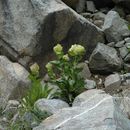Distribution
(
Inglês
)
fornecido por eFloras
Himalaya (Kashmir to Bhutan), N. Burma, S.W. China.
- licença
- cc-by-nc-sa-3.0
- direitos autorais
- Missouri Botanical Garden, 4344 Shaw Boulevard, St. Louis, MO, 63110 USA
Elevation Range
(
Inglês
)
fornecido por eFloras
3800-4600 m
- licença
- cc-by-nc-sa-3.0
- direitos autorais
- Missouri Botanical Garden, 4344 Shaw Boulevard, St. Louis, MO, 63110 USA
Cyclicity
(
Inglês
)
fornecido por Plants of Tibet
Flowering and fruiting from July to September.
- licença
- cc-by-nc
- direitos autorais
- Wen, Jun
Diagnostic Description
(
Inglês
)
fornecido por Plants of Tibet
Saussurea obvallata is close relative of Saussurea wettsteiniana, but differs from the latter in subtending leaves to 11 cm (vs. no more than 7 cm), capitula 6-15 (vs. 1-3), sessile (vs. with short peduncles), straight (pendent), phyllaries abaxially glandular hairy (vs. villous).
- licença
- cc-by-nc
- direitos autorais
- Wen, Jun
Distribution
(
Inglês
)
fornecido por Plants of Tibet
Saussurea obvallata is occurring in Gansu, Qinghai, Sichuan, Xizang, Yunnan of China, Bhutan, NW Indian, Kashmir, N Myanmar, Nepal, Pakistan, Sikkim.
- licença
- cc-by-nc
- direitos autorais
- Wen, Jun
General Description
(
Inglês
)
fornecido por Plants of Tibet
Herbs, perennial, 16-60 cm tall. Rhizomes thick, neck densely covered with brown fibrous lacerate residue of petioles. Stems erect, pubescent or glabrous. Basal leaves with to 8 cm petiole; leaf blade narrowly elliptic, oblong, or ovate, 7-20 cm long, 3-6 cm wide, glandular hairy, base cuneate, margin serrulate, apex obtuse. Stem leaves sessile, similar to basal leaves but gradually smaller towards stem apex. Uppermost stem leaves surrounding inflorescence, yellow, narrowly elliptic to ovate-oblong, to 16 cm long, 7 cm wide, membranous, pubescent or glandular hairy, margin serrulate, apex obtuse. Inflorescences terminal on stem, hemispherical. Capitula 6-15, pedunculate or not. Involucre hemispherical, 1-1.5 cm in diameter. Phyllaries in 4 rows, abaxially pubescent and glandular hairy, margin blackish purple, apex acute; outer phyllaries ovate; middle phyllaries elliptic; inner phyllaries linear. Pappus dark brown, in 2 rows; outer pappus ca. 5 mm, scabrous; inner pappus ca. 1.2 mm. Florets bluish purple, ca. 1.8 cm, tube ca. 8 mm, limb ca. 1 cm. Achene oblong, ca. 5 mm.
- licença
- cc-by-nc
- direitos autorais
- Wen, Jun
Genetics
(
Inglês
)
fornecido por Plants of Tibet
The chromosomal number of Saussurea obvallata is 2n = 32 (Gupta and Gill, 1989; Gupta et al., 1989; Amano and Ohba, 2000).
- licença
- cc-by-nc
- direitos autorais
- Wen, Jun
Habitat
(
Inglês
)
fornecido por Plants of Tibet
Growing in grassland, rocky places on mountain slopes, by streams, scree; 3200-4700 m.
- licença
- cc-by-nc
- direitos autorais
- Wen, Jun
Uses
(
Inglês
)
fornecido por Plants of Tibet
Saussurea obvallata was used as medically, used to treat paralysis of the limbs and cerebral ischemia.
- licença
- cc-by-nc
- direitos autorais
- Wen, Jun
Saussurea obvallata
(
Inglês
)
fornecido por wikipedia EN
Saussurea obvallata is a species of flowering plant in the Asteraceae. It is native to the Alpine meadows of the Himalayas, in India, Bhutan, Nepal, Pakistan and southwest China at altitudes of 3,700 to 4,600 m.[2]
Description
Saussurea obvallata is a perennial growing to 0.3 m (1 ft). The flowers are hermaphrodite (have both male and female organs) and are pollinated by insects. Flowers bloom in mid-monsoon (July–August) amongst the rocks and grasses of the hillside at an altitudinal range of 3700–4600 m. Flower heads are purple, hidden from view in layers of yellowish-green papery bracts, which provide protection from the cold mountain environment. The flowers can be seen from July through September, after which the above-ground portions of the plant die back, becoming visible again in April.[3][4]
The Saussurea genus are named for alpine scientist Horace Bénédict de Saussure, while the specific epithet obvallata is derived from obvallatus, meaning "surrounded by wall;" in this case the flower's involucriform bracts.[4]
Cultural recognition
A postal stamp featuring the image of the flower and labeled Sassurea obvallata in English and Brahma Kamal in the Devanagari script was issued by the Indian government in 1982. Sometime after the new state of Uttarakhand was created in 2007 (changing its name from Uttaranchal, created in 2000), the flower was declared the state flower.[5] The flowers are used as offering in the hill temples, like the shrines of Badrinath. The thick curved root of the plant is applied to bruises and cuts, as part of local medicine.[6]
References

- licença
- cc-by-sa-3.0
- direitos autorais
- Wikipedia authors and editors
Saussurea obvallata: Brief Summary
(
Inglês
)
fornecido por wikipedia EN
Saussurea obvallata is a species of flowering plant in the Asteraceae. It is native to the Alpine meadows of the Himalayas, in India, Bhutan, Nepal, Pakistan and southwest China at altitudes of 3,700 to 4,600 m.
- licença
- cc-by-sa-3.0
- direitos autorais
- Wikipedia authors and editors

